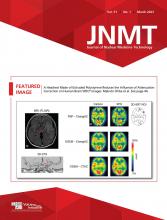Abstract
Hip fractures are common in the aging population, with complications such as avascular necrosis. We describe a case of an 85-y-old woman with early avascular necrosis as a complication from femoral neck fracture discovered on routine bone densitometry screening.
Avascular necrosis of the femoral head is a known complication of femoral neck fractures. Various imaging modalities, including MRI and bone scintigraphy, can be used to evaluate avascular necrosis.
CASE REPORT
An 85-y-old woman underwent routine screening bone densitometry. On the images, the femoral neck appeared foreshortened (Fig. 1), and radiography was recommended. Hip radiographs then showed a displaced subcapital left femoral neck fracture (Fig. 2), and chart review revealed that the patient had sustained a ground-level fall 3 wk beforehand. Whole-body bone scanning and MRI of the hip were performed to evaluate for avascular necrosis and osseous metastases. The bone scan showed photopenia over the left femoral head on blood pool and delayed images, raising concern about early avascular necrosis (Fig. 3). MRI showed a hypointense femoral head on T1-weighted sequences, confirming the diagnosis of avascular necrosis (Fig. 4). The patient subsequently underwent hemiarthroplasty of the left hip.
Dual-energy x-ray absorptiometry image suggesting foreshortened femoral neck. AM = age matched; BMC = bone mineral content; BMD = bone mineral density; DAP = dose area product; BMDCS/NHANES = Bone Mineral Density in Childhood Study/National Health and Nutrition Examination Surveys; LSC = least significant change; PR = peak reference; WHO = World Health Organization.
Anterior–posterior pelvic radiograph showing displaced subcapital femoral neck fracture.
Delayed-phase bone scintigraphy images showing photopenia over left femoral head, with expected uptake in femoral neck fracture. ANT = anterior; LAT = lateral; LT = left; POST = posterior; RT = right.
Coronal T1-weighted MR image through pelvis showing hypointense left femoral head.
DISCUSSION
Dual-energy x-ray absorptiometry is recommended for women aged 65 y or older to screen for osteopenia and osteoporosis (1). The goal of screening is to identify those at increased risk of an insufficiency fracture due to a low bone mass. Screening typically evaluates the hip and lumbar spine and, occasionally, the forearm. The World Health Organization has devised the Fracture Risk Assessment Tool to estimate the risk that a patient will sustain a major osteoporotic fracture or hip fracture, based, in part, on bone mineral density (2).
Hip fractures are problematic, particularly in the elderly, with complications such as avascular necrosis of the femoral head. In one study, the incidence of avascular necrosis in patients with femoral neck fractures was 14.3% (3). MRI is the gold standard for evaluating avascular necrosis (4). However, bone scintigraphy is an option. Expected findings on MRI are hypointensity on T1-weighted images, sometimes bordered by a hyperintense line. T2-weighted images may show the double-line sign, consisting of a hyperintense inner line between normal marrow and ischemic marrow. On bone scintigraphy, early avascular necrosis shows photopenia on all phases because of absence of blood flow. Late avascular necrosis shows increased bone tracer activity due to reparative uptake.
CONCLUSION
Bone densitometry is a useful screening tool for osteopenia and osteoporosis. The limited images may yield unexpected findings, as demonstrated in this case, during which a displaced femoral neck fracture was discovered. Avascular necrosis is a common complication of femoral neck fractures and can be evaluated with MRI or bone scintigraphy.
DISCLOSURE
The views expressed are solely those of the authors and do not reflect the official policy or position of the U.S. Air Force, the Department of Defense, or the U.S. Government. No potential conflict of interest relevant to this article was reported.
Footnotes
Published online Aug. 30, 2022.
- Received for publication May 4, 2022.
- Revision received July 29, 2022.











